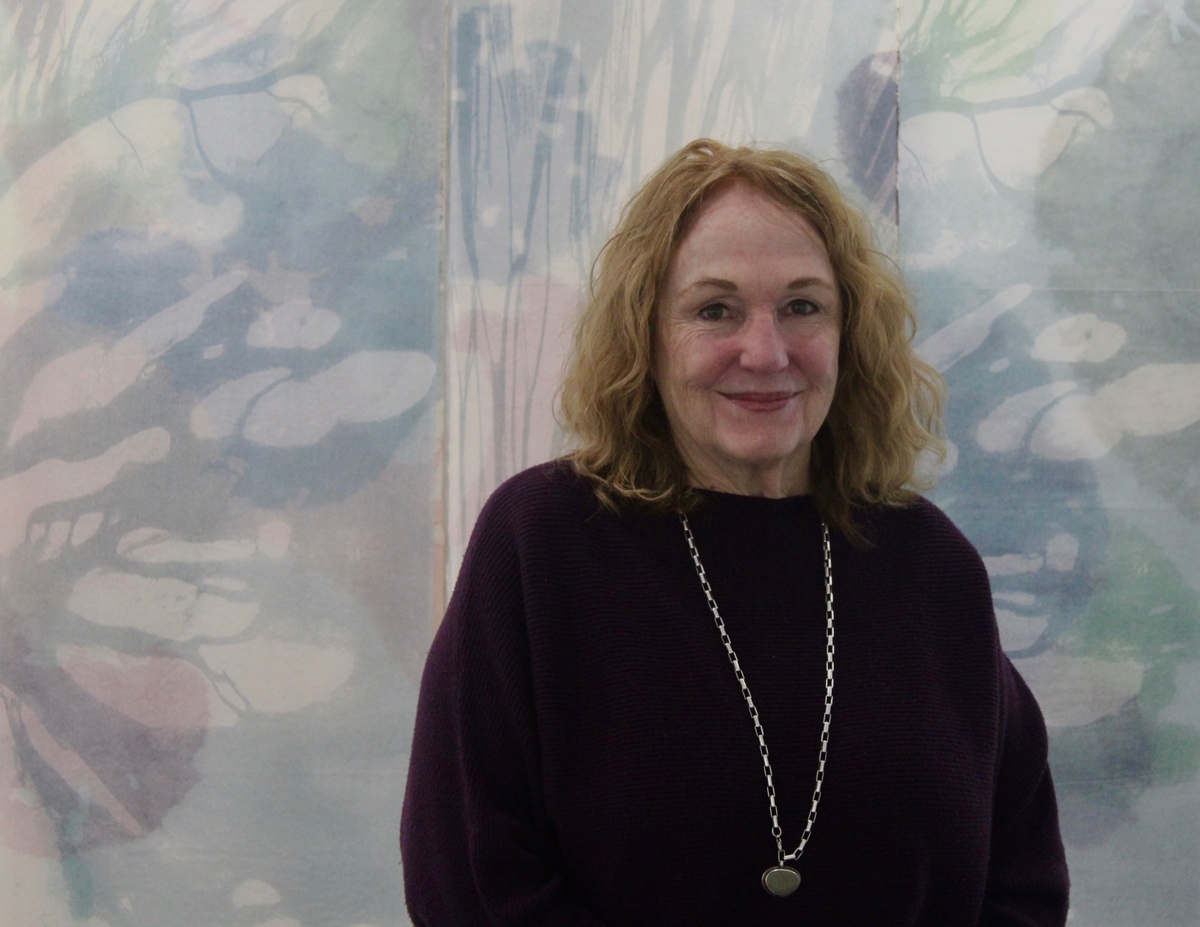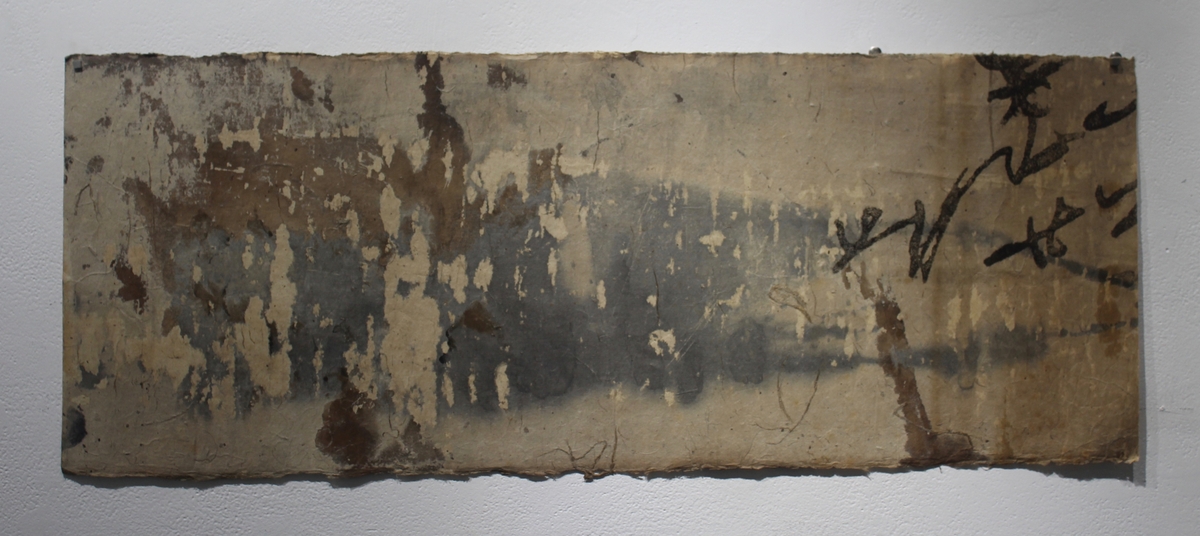
Harder with J Topog Rivulets 231.
After decades of printmaking, Barbara Harder revels in embracing the accidents. “I’m trying to make things the way I’m making them,” she said, but “sometimes I almost like tripping up,” because sometimes she likes the images she creates better. “You don’t have to beat yourself up more than you need to,” she continued. “It’s really nice to have the space as an artist to do that exploration, and wrestle with yourself, and the paper, and the ink.… It’s the hope that at times in the studio, I can have this spark… whether it’s done, or whether it’s perfect, or whatever it is, it just makes me happy. It’s something to keep after.”
The most recent results of Harder’s art practice are up now at City Gallery on Upper State Street, for a show entitled “Some Things …,” which runs now through Dec. 30.

Barbara Harder
J Topog Edo 231.
Harder has a long history of involvement in New Haven’s arts scene as an artist, organizer, and teacher. She has exhibited her work here and abroad, Scotland, England, Australia, India, and Japan. She has taught at Creative Arts Workshop since 1976 and was involved in Artspace in its first years at the intersection of Whitney and Audubon. She credited a grant from the Bitsie Clark Fund for Artists for helping her on her current artmaking path. She was the first recipient of the grant, in 2018. “It was really very validating” and “very much of a surprise,” she said. She planned to use the funds to travel to Japan and study washi, a Japanese handmade paper known for its beauty and durability. “Some Japanese papermakers have been designated as national treasures for their excellence in papermaking, sometimes using secrets handed down in families for generations,”
Harder said at the time. “I would like to visit as many of these papermaking artisans as possible, and bring examples of their special work to share with artists and craftspeople from around Connecticut.”
She booked her ticket in 2019 for 2020, only to have the flight cancelled by the pandemic. She finally made the trip this summer. It was her third trip there. It was the latest stop in her evolution as an artist.
“I started out as a person who could draw well in my younger years,” and made “Andrew Wyeth‑y kinds of things.” But she found her “happy place” as she moved into abstraction. She starting printing her abstractions on paper, and realized she had stumbled into a “very Asian aesthetic.” She had studied Asian art in college as well. Those artistic values continued to appear in her work. “As time went on, I kept getting drawn to it,” she said. “I don’t want to imitate it,” she added, and makes no claims to autheticity. “But there’s something there,” in the “simplicity, or the quietness, or the juxtapositions,” that continued to inspire her.
A key part of the aesthetic is to be open to the possibilities that printmaking allows. “There are many ways to transfer images to printmaking. You can control them and make them perfect. But you can find weird things happen when you print,” she said, and there are ways of using printmaking techniques and ink that make it harder to predict exactly how something will turn out, that feel more experimental, more exploratory. Over time, she has gravitated toward working that way. “I let the press be part of it, and react to what the press has done, or what I have done” by using the machines “in a certain way.” If the first attempt doesn’t feel complete, she tries another pressing. “You can always put another layer of ink on stuff,” she said. “For me, there’s this incredibly interesting dialogue” between her and the process.

Barbara Harder
J Topog Jane 231.
That extends to the “crisp, delicious” paper Harder makes the prints on. Washi paper is strong, but “there’s something very delicate about it” as well, Harder said. “Some of it just grabs an image” and “some of it you have to fight with.” It turns out that, often, “I like fighting with it, and having a dialogue about how I can make it do something I want to see.” Some of “my best prints,” she said, have been pieces in which the first printing layer is something of a disaster; then “I can try anything because I’m not going to kill it. It’s dead already.” She has done some pieces with 27 translucent layers of printing on them. “It’s really, really fun. When I can get into my studio and give myself enough time — sometimes it’s horrible, but eventually it gets somewhere.”
As she could always add more, Harder doesn’t always know when she’s done. Sometimes she’s done with a piece simply because she’s tired of working on it. Other times she’s used the same stencil over and over (as with the stencil for Edo, which she used for 10 years). She keeps the pieces open to happy accidents; sometimes a piece looks better upside down than in the orientation she originally imagined. “I don’t know that it’s ever done perfectly,” she said. But “you get a feeling,” or “you walk into the studio two days later” and see that piece needs only a little more, or nothing at all. She also takes advice from visitors to her studio who declare a piece finished or think it needs more. “You keep hanging it up until you find a solution you like,” she said.
The sense of playfulness in incompleteness even applies to the current City Gallery show. Harder left open the idea that she might swap out some pieces for other pieces during the show’s run. “I’ve always wanted to do this,” she said about changing a show while it’s up. “I think I’ve gotten enough ideas that I can try some changes.” Will the changes make the show better? “That’s a question,” she said with a smile. “I might have to rearrange the show if I mess it up too much, but that’s okay.” And “I don’t put up anything that I don’t really like.”
In her practice, she’s far away from the idea some artists have of working on a piece for years to try to make it perfect. “I’m an old lady,” she said. “I don’t have time for that,” she said, laughing. “I never had time for that.”